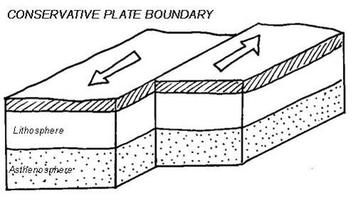
At subduction zones the relatively cold, dense oceanic crust sinks down into the mantle over the downward convecting limb of a mantle cell. Plate movement is thought to be driven by a combination of the motion of the seafloor away from spreading ridges due to variations in topography (the ridge is a topographic high) and density changes in the crust (density increases as newly-formed crust cools and moves away from the ridge). Lateral density variations in the mantle result in convection that is, the slow creeping motion of Earth's solid mantle. Tectonic plates are able to move because Earth's lithosphere has greater mechanical strength than the underlying asthenosphere. Earlier theories, since disproven, proposed gradual shrinking (contraction) or gradual expansion of the globe. This prediction of plate tectonics is also referred to as the conveyor belt principle. In this way, the total geoid surface area of the lithosphere remains constant. Along convergent boundaries, the process of subduction, or one plate moving under another, carries the edge of the lower one down into the mantle the area of material lost is balanced by the formation of new (oceanic) crust along divergent margins by seafloor spreading.

Tectonic plates are composed of the oceanic lithosphere and the thicker continental lithosphere, each topped by its own kind of crust. The relative movement of the plates typically ranges from zero to 10 cm annually. Earthquakes, volcanic activity, mountain-building, and oceanic trench formation occur along these plate boundaries (or faults). Where the plates meet, their relative motion determines the type of plate boundary: convergent, divergent, or transform. Plate tectonics came to be generally accepted by geoscientists after seafloor spreading was validated in the mid to late 1960s.Įarth's lithosphere, which is the rigid outermost shell of the planet (the crust and upper mantle), is broken into seven or eight major plates (depending on how they are defined) and many minor plates or "platelets". The model builds on the concept of continental drift, an idea developed during the first decades of the 20th century. The Puerto Rico Trench is located at a boundary between two plates that pass each other along a transform boundary with only a small component of subduction.Plate tectonics (from the Late Latin: tectonicus, from the Ancient Greek: τεκτονικός, lit.'pertaining to building') is the generally accepted scientific theory that considers the Earth's lithosphere to comprise a number of large tectonic plates which have been slowly moving since about 3.4 billion years ago. The Puerto Rico trench is at a complex transition from the subduction boundary to the south and the transform boundary to the west. Our structural interpretation of the transform boundary geometry shows that the ridge and platform margin segments were each subjected to separate thermal influences from two different migrating spreading centres. The San Andreas Fault, a transform boundary, runs south from the junction, separating the Pacific Plate and the North American Plate.

The EPG fault system makes up a transform boundary that separates the Gonâve microplate the fragment of the North American Plate upon which Haiti is situated from the Caribbean Plate. Running west from the triple junction is the Mendocino Fault, the transform boundary between the Gorda Plate and the Pacific Plate.

The Gagua Ridge thus represents failed subduction along a former fracture zone or transform boundary between two oceanic basins. The mode of failure along that transform boundary is unknown, but we can learn from similar known or recent geodynamic contexts.


 0 kommentar(er)
0 kommentar(er)
